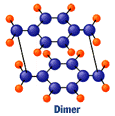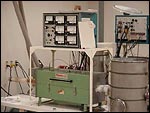Discovery and Early History of Parylene
By 1947, Michael Mojzesz Swarc had escaped the ravages of Eastern
Europe and was launching an academic career in Physical
Chemistry at the University of Manchester, England. His
interest in the strength of individual chemical bonds had
developed to the point of investigating a class of aliphatic
carbon-hydrogen bonds in which the carbon was directly
attached to a benzene ring. Experimentally, he heated the
simplest compounds having these groups- toluene and the
xylenes, ortho-, meta- and para-, as gases to very high
temperatures and followed their degradation products and the
rates at which they decomposed, both as a function of
temperature.
 In the para-xlene case only, downstream
from the pyrolysis zone in the cooler reaches of the glass equipment, a
tan colored deposit formed, which on disassembly of the apparatus could be
removed as a thin, filmsy, tube-shaped mass, "the skin of a small snake".
He correctly deduced that it had been formed by the polymerization of a
specific reaction product of p-xlene, called p-xylyene. Taking his
observations one step beyond the immediate requirements of his project (a
model investigator), he noted the new polymer's exceptional physical and
chemical inertness and wondered whether this "Szwarcite" might have some
utility. Michael's snakeskin was the world's first vapor deposited poly (para-xylylene)
(PPX), which in purer colorless form we know today as Parylene N. In the para-xlene case only, downstream
from the pyrolysis zone in the cooler reaches of the glass equipment, a
tan colored deposit formed, which on disassembly of the apparatus could be
removed as a thin, filmsy, tube-shaped mass, "the skin of a small snake".
He correctly deduced that it had been formed by the polymerization of a
specific reaction product of p-xlene, called p-xylyene. Taking his
observations one step beyond the immediate requirements of his project (a
model investigator), he noted the new polymer's exceptional physical and
chemical inertness and wondered whether this "Szwarcite" might have some
utility. Michael's snakeskin was the world's first vapor deposited poly (para-xylylene)
(PPX), which in purer colorless form we know today as Parylene N.
To the young
and growing plastics industry of that day, better thermal stability as a
cherished quality in prospective new polymers, and Michael's observations
inspired vigorous research in many industrial laboratories, including
I.C.I. in the U. K. and DuPont, Kellogg and Polaroid in the U.S. At Union
Carbide, about five years later, William Franklin Gorman proposed using
the very stable dimer of the reactive p-xylylene, di-p-xylylene (DPX), or
[2.2] paracyclophane, as the feedstock for an industrial Vapor Deposition
Polymerization (VDP) process to produce PPX. He demonstrated that the
necessary reactive intermediate could be produced quantitatively in pure
form from DPX under milder conditions than those required for its
production from p-xylene. A further advantage of the Gorham proposal is
the absence of gaseous byproducts, a feature of the production of p-xylylene
by all other means presently known.
The trouble
with the Gorham proposal was that DPX at the time was only a chemical
curiosity. It had been isolated as an impurity in the Szwarc snakeskin,
and only tiny amounts were available for its characterization in 1949. Its
peculiar strained structure intrigued the academic community, and soon the
problem of its synthesis by more conventional means was reported solved in
1951 at the U.C.L.A. Laboratory of Donald Cram (Nobel Laureate, 1988).
However, much work remained to be done at Union Carbide before the Gorham
proposal could be considered a commercially viable process. This
preliminary work culminated in an announcement on February 17, 1965 of the
availability of a new polymeric coating system, the Parylenes, consisting
of both a new family of polymers plus a unique vacuum method for applying
them. Truth be known, Union Carbide developed over 20 types of Parylene,
but for numerous reasons, only 3 were deemed commercially viable.
The
Commercialization of Parylene
| |

Picture of one of the original pieces of SCS Parylene coating
equipment.
|
William F. Gorham's work with Union Carbide made Parylene a
commercially viable process.
In 1971, Nova
Tran Limited was established in Clear Lake, WI. Nova Tran purchased a
license agreement from Union Carbide to be one of the world's first
Parylene Coaters.
Nova Tran's
track record of success and experience developing the Parylene industry,
drew much interest from Union Carbide. In 1991, Union Carbide purchased
Nova Tran, to bring Parylene commercialization in house.
When Union
Carbide purchased Nova Tran they transferred all information regarding the
development of Parylene and all patents to the newly renamed Specialty
Coating Systems.
In 1994,
Cookson Electronics purchased Specialty Coating Systems from Union
Carbide. In 1998, Cookson Electronics placed SCS in their Speedline
Technologies Division, which was renamed to Cookson Electronics Equipment
Group in 2002.
If you don't find what you're looking for,
Contact Us.
We may have a suitable product that's not listed, or we may be
able to develop a material to fit your specific needs.
Tel : (02)2217-3442 / Fax : (02)2704-4070
|
|

